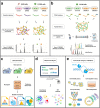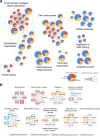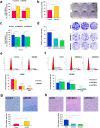MCM2-regulated functional networks in lung cancer by multi-dimensional proteomic approach
- PMID: 29038488
- PMCID: PMC5643318
- DOI: 10.1038/s41598-017-13440-x
MCM2-regulated functional networks in lung cancer by multi-dimensional proteomic approach
Abstract
DNA replication control is vital for maintaining genome stability and the cell cycle, perhaps most notably during cell division. Malignancies often exhibit defective minichromosome maintenance protein 2 (MCM2), a cancer proliferation biomarker that serves as a licensing factor in the initiation of DNA replication. MCM2 is also known to be one of the ATPase active sites that facilitates conformational changes and drives DNA unwinding at the origin of DNA replication. However, the biological networks of MCM2 in lung cancer cells via protein phosphorylation remain unmapped. The RNA-seq datasets from The Cancer Genome Atlas (TCGA) revealed that MCM2 overexpression is correlated with poor survival rate in lung cancer patients. To uncover MCM2-regulated functional networks in lung cancer, we performed multi-dimensional proteomic approach by integrating analysis of the phosphoproteome and proteome, and identified a total of 2361 phosphorylation sites on 753 phosphoproteins, and 4672 proteins. We found that the deregulation of MCM2 is involved in lung cancer cell proliferation, the cell cycle, and migration. Furthermore, HMGA1S99 phosphorylation was found to be differentially expressed under MCM2 perturbation in opposite directions, and plays an important role in regulating lung cancer cell proliferation. This study therefore enhances our capacity to therapeutically target cancer-specific phosphoproteins.
Conflict of interest statement
The authors declare that they have no competing interests.
Figures







Similar articles
-
MCM2 in human cancer: functions, mechanisms, and clinical significance.Mol Med. 2022 Oct 27;28(1):128. doi: 10.1186/s10020-022-00555-9. Mol Med. 2022. PMID: 36303105 Free PMC article. Review.
-
Minichromosome maintenance protein 2 and 3 promote osteosarcoma progression via DHX9 and predict poor patient prognosis.Oncotarget. 2017 Apr 18;8(16):26380-26393. doi: 10.18632/oncotarget.15474. Oncotarget. 2017. PMID: 28460433 Free PMC article.
-
Identification of candidate biomarkers and pathways associated with SCLC by bioinformatics analysis.Mol Med Rep. 2018 Aug;18(2):1538-1550. doi: 10.3892/mmr.2018.9095. Epub 2018 May 29. Mol Med Rep. 2018. PMID: 29845250 Free PMC article.
-
Prognostic significance of MCM2, Ki-67 and gelsolin in non-small cell lung cancer.BMC Cancer. 2006 Aug 1;6:203. doi: 10.1186/1471-2407-6-203. BMC Cancer. 2006. PMID: 16882345 Free PMC article.
-
The MCM2-7 Complex: Roles beyond DNA Unwinding.Biology (Basel). 2024 Apr 13;13(4):258. doi: 10.3390/biology13040258. Biology (Basel). 2024. PMID: 38666870 Free PMC article. Review.
Cited by
-
High Mobility Group A1 (HMGA1): Structure, Biological Function, and Therapeutic Potential.Int J Biol Sci. 2022 Jul 4;18(11):4414-4431. doi: 10.7150/ijbs.72952. eCollection 2022. Int J Biol Sci. 2022. PMID: 35864955 Free PMC article. Review.
-
MCM2 in human cancer: functions, mechanisms, and clinical significance.Mol Med. 2022 Oct 27;28(1):128. doi: 10.1186/s10020-022-00555-9. Mol Med. 2022. PMID: 36303105 Free PMC article. Review.
-
ZNF322A-mediated protein phosphorylation induces autophagosome formation through modulation of IRS1-AKT glucose uptake and HSP-elicited UPR in lung cancer.J Biomed Sci. 2020 Jun 23;27(1):75. doi: 10.1186/s12929-020-00668-5. J Biomed Sci. 2020. PMID: 32576196 Free PMC article.
-
Quantitative Phosphoproteomics Reveals Cell Alignment and Mitochondrial Length Change under Cyclic Stretching in Lung Cells.Int J Mol Sci. 2020 Jun 7;21(11):4074. doi: 10.3390/ijms21114074. Int J Mol Sci. 2020. PMID: 32517296 Free PMC article.
-
Focused cancer pathway analysis revealed unique therapeutic targets in retinoblastoma.Med Oncol. 2024 Jun 4;41(7):168. doi: 10.1007/s12032-024-02391-9. Med Oncol. 2024. PMID: 38834895
References
Publication types
MeSH terms
Substances
LinkOut - more resources
Full Text Sources
Other Literature Sources
Medical
Molecular Biology Databases
Research Materials
Miscellaneous

